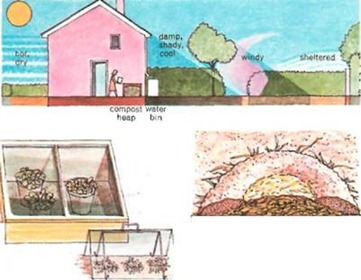





The gardening cycle is complete. At this stage we are back at the same time of year we started with Stage 1. We’re back to the time to sow our first annual seeds for this year – this time sweet peas. We also take a look at plant diseases, fungicides, and learn a few more gardening skills. By now you should have learnt enough to be branching out on your own. There’s not a heavy work-programme this fortnight so that you can put some of your own ideas into practice.
Needs list: 1 pkt sweet pea seed.
Time budget: 1 hour in 2 weeks
Early April brings the weather/soil notes full cycle. This is where we came in. Air temperature is rising, and soils are warming up and drying out. Time too for you to get out into the garden and get to work again. This, your second gardening year, do project work you missed last year.
Sweet peas, along with roses, chrysanthemums and dahlias, are one of the truly great garden flowers, known, grown, loved and treasured for decades. You can get sweet peas in every colour except pure yellow -and the breeders are working on that. At one time sweet peas were widely grown for the show bench: now they’re usually grown just to glorify the garden. Modern dwarf strains like the Bijou sweet pea, which grows only 1 ft. high, needs only a few twigs to support it. These and the taller strains look lovely grown in circular clumps like gladioli. Prick transplants outdoors about the end of April in the bed still occupied by the spring bulbs, or any warm, sunny border.

Time to make a start on your lawn care programme for the year to come. Buy yourself a wire lawn rake. It’s a multi-purpose tool, rakes fallen leaves, moss, old lawn clippings out of the grass, aerates it too. Rake the whole lawn, first one way, then across it at right angles to the line of the first raking. Change your mowing patterns occasionally too and mow cross-ways from time to time. Repair damaged lawn edges by cutting turves (Stage 8) replace by reversing front to back. Fill holes. Seed bare areas. Alternatively, consider supporting edges with proprietary metal or plastic edging strip. Set strip low enough in lawn to allow the mower to clear it. Later, start feeding the lawn. Keep feeding through the growing season. Prick out sweet pea seedlings (Stage 24) when they’re 2 in. tall, place 10 in. apart. Put in supporting stakes, strings, wires.
Care for plant gifts. Keep house plant azaleas, house plant cyclamen moist, in west window. Keep inside curtains at night. Re-pot: stand outdoors May/ June. Dry off poinsettias, cut down.
Every garden is different from every other garden. Even in a street of identical houses with gardens of identical size and shape, the differences can be substantial. It makes a difference whether the people next door or even two houses away have a fence or haven’t: have a hedge or haven’t. Maybe your garden is shaded by a big tree next door: or it’s on the other side, casts no shade in your garden but drinks all the water from under your lawn.
Get to know your garden; note the hot, dry ; note the shaded spots which usually cool and damp. Learn draughts get through holes in hedges, fences, shelter belts. Grow shade-lovers in shade – sun-lovers in sun. If you live on a hillside, make a gap in the hedge/fence at the bottom of the slope to let the frost drain away (frost sinks like hot air rises).
Take advantage of a sunny part of the garden to make a cold frame. Start with a second-hand window, build frame to fit. Cheats the late frosts of its last victims: gives you 2-3 weeks head start over the weather with your seeds. You can sow seed earlier, and use the frame to grow on tender young seedlings or bought-in transplants.
Use cloches/ tents in the same way. Protect plants against hard winter frosts by heaping bracken/straw and peat over them. Start sweet pea seeds now for summer display. Sow in soilless growing mix, in peat pots or boxes. Protect with glass (Stage 3). Use netting (Stage 3), stakes (Stage 8) or branches for supports.
Protect against slugs with slug pellets. Learn a strict regime of garden hygiene: never leave diseased leaves/ branches/flowers on plants. Cut off and burn them.
Never leave prunings, dead vegetable matter lying around in garden. Compost bin or burn. More plants are killed, damaged, made ugly by bacteria than anything else. Hygiene helps avoid problems.
Use Bordeaux mixture (ask your garden centre) against fungus diseases.
Two Hour Gardening Project: Stage 26 Climbing Plants and Pergolas
Two Hour Gardening Project: Stage 24 Propagation and Growing Herbs
Two Hour Gardening Project: Stage 23 Principles of Pruning
Two Hour Gardening Project: Stage 21 Making Christmas Present Plants
Two Hour Gardening Project: Stage 20 Tubs and Container Gardening
Two Hour Gardening Project: Stage 17 Fan Trained Fruit Trees
Copyright © www.100flowers.win Botanic Garden All Rights Reserved